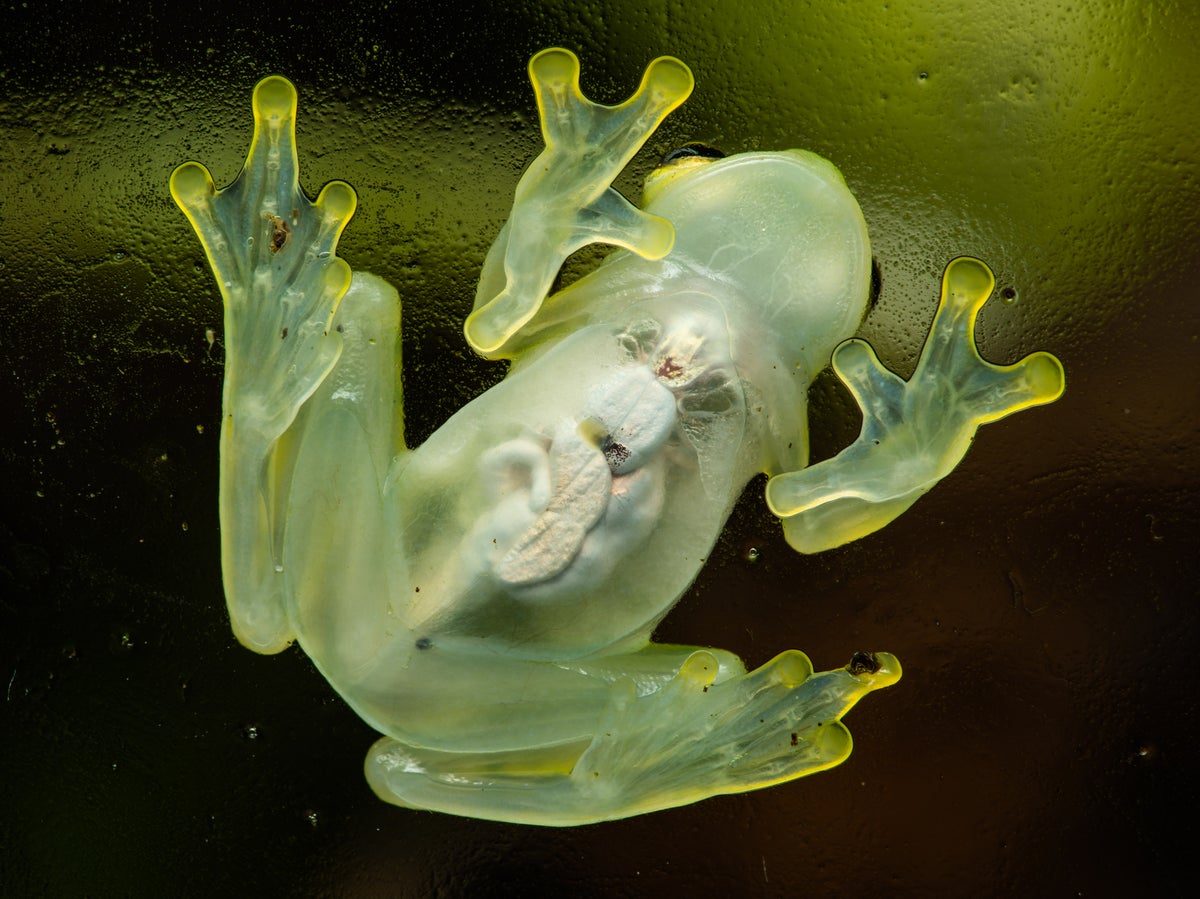Glass frogs become transparent by hiding red blood cells in their livers, study finds

Amphibians like glass frogs become see-through whilst sleeping – and now scientists have discovered how.
The creatures hide 90 per cent of their red blood cells in their liver, which is mirror-coated, so their eyes, bones and internal organs become all that is visible.
Despite this they manage to avoid getting a massive clot, and when they wake up the blood flows back out into their whole body again.
Study author Dr Sönke Johnsen from Duke University in the US explained: “Whenever glass frogs want to be transparent, which is typically when they’re at rest and vulnerable to predation, they filter nearly all the red blood cells out of their blood and hide them in a mirror-coated liver, somehow avoiding creating a huge blood clot in the process.”
“Whenever the frogs need to become active again, they bring the cells back into the blood stream, which gives them the metabolic capacity to move around.”
The creatures – which live in the southern US, Central America, the Caribbean and northern South America – are nocturnal animals that sleep upside down on translucent leaves that match the colour of their backs.
They can be almost impossible to spot when they are awake because they are just a few centimetres long and are most active at night when their green skin helps them blend in with surrounding grass and leaves.
However, they become true masters of camouflage when they are asleep.
While many sea creatures including ice fish and larval eels can become transparent or change the colour of their skin, that skill is far less common on land. Glass frogs do it to make it harder for predators to spot them.
Red blood cells in the circulatory system make it difficult for most animals to become transparent.
These cells are good at absorbing green light, which is the colour of light normally reflected by plants and other vegetation.
In return, oxygen-rich red blood cells reflect red light which makes blood and the circulatory system highly visible, especially against a bright green leaf.
Glass frogs are one of just a few land-based vertebrates that can become transparent, which has made researchers particularly interested in them, but few have understood the process until now.
The glass frog’s translucent legs makes its outline less recognisable to predators and harder to spot
(Getty Images/iStockphoto)
For the study, the team focused on one particular type of glass frog called hyalinobatrachium fleischmanni.
The researchers travelled the world collecting glass frogs and conducted imaging tests on them.
They used them to produce optical models which proved animals were able to become transparent by pushing red blood cells out of their vessels.
The team suspected that the cells were being stored in one of the frog’s inner organs which are packaged in a reflective membrane.
They explained that for a see-through animal, its biology was “shockingly” difficult to decipher.
Experts from across the US had to help the team get to grips with it.
Study author Dr Jesse Delia, who now works at the American Museum of Natural History, explained: “If these frogs are awake, stressed or under anaesthesia their circulatory system is full of red blood cells and they are opaque.
“The only way to study transparency is if these animals are happily asleep, which is difficult to achieve in a research lab.
“We were really banging our heads against the wall for a solution.”
However, the team learned about an imaging technology called photoacoustic microscopy (PAM) which they used to make the discovery.
This process involves shooting a safe laser beam of light into a tissue, which is absorbed by molecules and converted into ultrasonic waves.
These sound waves are then used to make detailed biomedical images of the molecules. The imaging tool is non-invasive, quiet and sensitive.
Professor Junjie Yao, who specialises in PAM technologies at Duke explained: “The red blood cells themselves provide the contrast, because different types of cells absorb and reflect different wavelengths of light.
“We could optimise our imaging systems to specifically look for red blood cells and track how much oxygen was circulating in the frog’s bodies.”
During the study, the frogs slept upside down in a petri-dish which is similar to how they would sleep on a leaf. The researchers then shined a green laser at them.
Red blood cells in the frog’s body absorbed the green light and emitted ultrasonic waves, which were then picked up by an acoustic sensor to trace their whereabouts.
The team now want to look at the process of how they manage to store so many cells in their livers to understand more about human vascular health.
Dr Delia added: “This is the first of a series of studies documenting the physiology of vertebrate transparency, and it will hopefully stimulate biomedical work to translate these frogs’ extreme physiology into novel targets for human health and medicine.”
The findings were published in the Journal of Science.
For all the latest Science News Click Here
For the latest news and updates, follow us on Google News.

